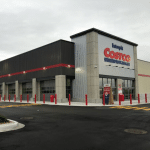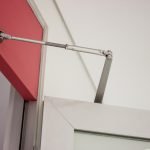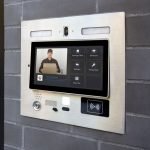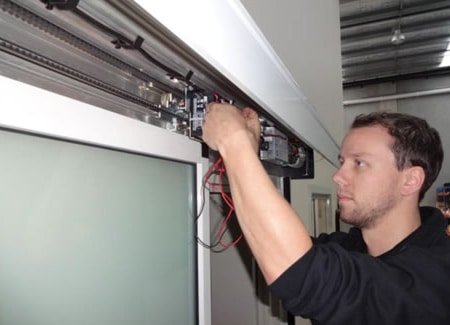Most people, especially those in the healthcare industry, are familiar with sayings such as “an apple a day keeps the doctor away” and “an ounce of prevention is worth a pound of cure.” These adages serve to remind individuals that by taking proactive measures to safeguard their health, they can help avoid potential health problems in the long run.
When it comes to automatic doors, a variation of this same straightforward logic applies. To circumvent costly, bothersome and potentially dangerous problems with the automatic doors in your healthcare facility, prevention entails proper selection, planned maintenance and daily safety checks.
SELECTION
To choose the right automatic door for any application, the facility layout, types of users, density of traffic, desired visual impression and expected abuse must all be considered. Additionally, there are often many added and complex requirements to take into account when selecting automatic doors for healthcare facilities. Automatic doors in hospitals, doctors offices, surgical centers and other healthcare settings frequently play an important role in keeping patients, employees, pharmaceuticals, sensitive medical records and expensive medical equipment safe and secure. Furthermore, large access areas are often compulsory in healthcare facilities to enable easy transfer of beds and gurneys, so the design of the selected doors must support this as well. Together, the facility owner, Designer and door supplier must take the responsibility of ensuring the doors work with the facility’s security system.
There are three basic types of automatic doors: automatic sliding doors, automatic swinging doors and automatic folding doors. Many manufacturers offer door models that have been specifically developed for special care facilities. These models are often designed to enable ongoing observation of patients, without the disturbance of outside noise. Some are also designed to make it possible to open the doors to the full width of the doorway in emergency situations, thereby allowing staff to move large beds and cumbersome equipment quickly and easily.
One of the first challenges in automatic door selection for any facility is settling upon a manufacturer. It is vital that potential manufacturers fully understand the specific needs and preferences of your facility so they can appropriately advise you of their product offerings and arm you with all of the information you will require to make an informed
decision as to whether or not they are the right match.
MAINTENANCE
Once all critical issues have been considered and the selection process is completed, it’s time to consider a planned maintenance program for your new doors. Steps need to be taken to protect any investment, and automatic doors are no exception. A planned maintenance program can significantly reduce the cost of ownership by increasing performance life and keeping emergency service calls to a minimum.
There are numerous kinds of planned maintenance programs available. The number of automatic doors the facility owns, the amount of customer traffic, the age of the automatic doors and the proprietor’s overall attitude toward maintenance programs typically influence which program is chosen. Manufacturers generally offer a range of programs that extend from basic to full-service.
Full Service Maintenance
A full service contract includes all of the advantages of a basic planned maintenance contract, but usually has a set price per door for repairs. A full service contract can generally be structured per year or per visit. In most agreements, it includes all parts and labor, routine service calls and any calls during business hours.
According to AAADM, one of the biggest benefits of a full service contract is that it gives customers the ability to fairly accurately budget every dollar they will spend on door service costs throughout the fiscal year and predict the dollars ahead of time. Furthermore, a full service plan ensures that doors are operating in prime condition and unscheduled downtime is reduced.
DAILY SAFETY CHECKS
You should perform daily safety checks on each automatic door. For clients’ safety and your own protection, you may wish to perform these checks while traffic is light. It does not matter when you conduct your daily safety checks, but it is a good idea to get in the habit of doing them at the same time every day. It is advisable to check your door each morning when the power is turned on to the door system or after any loss of electrical power. always exercise caution when performing daily safety checks
Case Closed
With 50 billion safe automatic door openings and closings every year in the Canada alone, automatic doors hold an exceptional safety record. Automatic doors are manufactured with the most sophisticated technologies that ensure the safest and most efficient performance from each component of the door system. The key to safety is proper specification, installation and maintenance.
DAILY SAFETY CHECKS
Sensor Activation/Presence Detection Safety Checks
In general, start by checking the electronic sensor by walking toward the door opening at a moderate speed at various angles. The door should start opening as you approach, should swing or slide open smoothly and stop without impact. As you move slowly toward the door, it should remain open. For doors that are used for two-way traffic, you should repeat this process from the other side of the opening.
Now, step out of the sensor zone or off the floor mat. After a brief time delay, the door should close.
Approach the safety side of the swinging door first, then have someone else approach the activating side of the door. As long as you are in the safety area of the door, it should not open. It is recommended that you observe the traffic coming to the door and plan the traffic patterns so that people will approach the doors from straight on and not from an angle.
Further, if your doors are equipped with electronic holding beams, you should cover each doorway holding the beam with your hand and stand motionless for several seconds. The door should remain open. Remove your hand and the door should close after the time delay expires. If other safety devices are being used, crouch motionless in the door opening for ten seconds. The door should not close. If door continues to close, this would reflect a malfunction of the safety sensor.
























